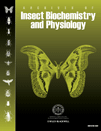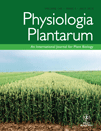
JOURNAL OF EVOLUTIONARY BIOCHEMISTRY AND PHYSIOLOGY
Scope & Guideline
Exploring the Nexus of Biochemistry and Evolutionary Dynamics
Introduction
Aims and Scopes
- Biochemical Mechanisms:
Research in this area investigates the biochemical pathways and processes that govern cellular and physiological functions in different organisms, often linking these mechanisms to evolutionary adaptations. - Physiological Responses:
This scope covers studies on how organisms respond physiologically to various stimuli, including environmental changes, stressors, and pharmacological agents, emphasizing the adaptive significance of these responses. - Comparative Physiology:
The journal promotes comparative studies across species to highlight evolutionary trends and physiological adaptations, facilitating a deeper understanding of how different organisms cope with similar challenges. - Neurobiological Studies:
Neurobiology is a significant focus, examining the biochemical and physiological underpinnings of neural function and behavior, and how these aspects evolve across species. - Ecophysiology:
Research in ecophysiology emphasizes the relationship between physiological processes and environmental factors, exploring how organisms adapt biochemically and physiologically to their habitats. - Molecular Genetics and Evolution:
The integration of molecular genetics with evolutionary biology is a core area, focusing on how genetic variations influence physiological traits and adaptations over time. - Health and Disease Models:
The journal includes studies that utilize animal models to understand disease mechanisms from a biochemical and physiological perspective, providing insights into evolutionary aspects of health and disease.
Trending and Emerging
- Integrative Approaches to Physiology:
There is a marked trend towards integrative research that combines physiological, biochemical, and ecological perspectives, reflecting a holistic understanding of organismal biology. - Neurophysiology and Neurobiology:
Emerging research focuses on the neurobiological aspects of physiology, particularly how neural mechanisms influence behavior and adaptation, highlighting the evolutionary significance of these processes. - Impact of Environmental Stressors:
Studies examining the effects of environmental stressors on physiological and biochemical responses are gaining importance, particularly in the context of climate change and habitat alterations. - Translational Research in Health:
An increasing number of studies are translating findings from evolutionary physiology into clinical contexts, particularly concerning metabolic disorders, neurodegenerative diseases, and stress responses. - Molecular Evolution of Physiological Traits:
Emerging research is delving into the molecular evolution of specific physiological traits, linking genetic variations with evolutionary adaptations and functional outcomes. - Interdisciplinary Studies:
There is a growing trend towards interdisciplinary research that bridges evolutionary biology with other fields such as ecology, genetics, and environmental science, facilitating comprehensive insights into organismal adaptation.
Declining or Waning
- Traditional Pharmacological Studies:
There has been a noticeable decline in the publication of studies focused solely on traditional pharmacological approaches, with a shift towards more integrative studies that combine pharmacology with physiological and evolutionary insights. - Basic Biochemical Pathway Descriptions:
While still relevant, the emphasis on purely descriptive studies of biochemical pathways without evolutionary context is waning, as the journal increasingly favors research that connects these pathways to physiological adaptations and evolutionary biology. - Single-Species Physiological Studies:
Research concentrating solely on a single species without comparative or evolutionary frameworks is becoming less common, as the journal encourages broader comparative approaches that assess physiological traits across multiple species. - Laboratory-Only Studies:
There is a diminishing focus on studies conducted exclusively in laboratory settings, with a growing preference for research that incorporates field studies or ecological contexts to enhance the understanding of physiological adaptations in natural environments.
Similar Journals

ARCHIVES OF INSECT BIOCHEMISTRY AND PHYSIOLOGY
Driving Innovation in Insect Research and ApplicationsArchives of Insect Biochemistry and Physiology, an esteemed journal published by WILEY, stands at the forefront of advancing the understanding of insect physiology and biochemistry. With an ISSN of 0739-4462 and E-ISSN of 1520-6327, this journal serves as a critical resource for researchers and professionals in the fields of biochemistry, insect science, and physiology. As of 2023, it holds a respectable impact factor with a Q3 ranking in Biochemistry and Physiology, and a Q2 in Insect Science, highlighting its relevant contributions to these disciplines. The journal has maintained a continuous publication history from 1983 to 2024, hosting pioneering research and review articles that inform both academic and practical applications in entomology. While it does not currently offer open access, it is accessible through various institutional subscriptions, ensuring widespread availability of essential findings. This journal plays a vital role in elucidating the complex biochemical pathways and physiological adaptations of insects, fostering knowledge that is crucial for ecological research, agricultural development, and conservation efforts.

Fishes is a premier academic journal dedicated to the exploration and dissemination of cutting-edge research in the fields of aquatic science and ecology. Published by MDPI in Switzerland, this open-access journal has been accessible to researchers globally since its inception in 2016, allowing for the rapid exchange of knowledge that fosters scientific advancement in the study of fish and aquatic ecosystems. With its convergence in the years 2016 to 2024, Fishes proudly holds a notable position in the academic community, evidenced by its category quartile rankings of Q3 in Aquatic Science and Q2 in Ecology for 2023. The journal consistently features innovative research encompassing ecological interactions, conservation strategies, and evolutionary studies within aquatic environments. By integrating interdisciplinary approaches and encouraging contributions from a diverse array of experts, Fishes serves as an invaluable resource for researchers, professionals, and students alike, contributing to the understanding and preservation of our precious aquatic biodiversity.

Open Biology
Exploring the depths of life sciences with global insights.Open Biology is a prestigious, interdisciplinary journal published by the Royal Society that has been paving the way in the fields of Biochemistry, Genetics and Molecular Biology, Immunology, and Neuroscience since its inception in 2011. Catering to a global audience of researchers, professionals, and students, Open Biology operates under an open access model, facilitating the unrestricted dissemination of high-quality research findings. With a current impact factor that positions its categories in the top quartile (Q1) and impressive Scopus rankings—evidencing its influence and reach—this journal serves as a vital platform for innovators and scientific inquiries aimed at advancing our understanding of life sciences. The journal's commitment to publishing cutting-edge research makes it an essential resource for those at the forefront of scientific exploration.

PHYSIOLOGIA PLANTARUM
Charting New Territories in Plant Research and GeneticsPHYSIOLOGIA PLANTARUM, published by WILEY, is a prestigious journal in the fields of plant science, physiology, and genetics, known for its impactful contributions since its inception in 1948. With an impressive impact factor and a consistent ranking in the Q1 and Q2 quartiles, it stands out in critical disciplines such as cell biology and biochemistry, ranking #24 in Plant Science with a remarkable 95th percentile standing. This journal primarily serves researchers and professionals committed to advancing the understanding of plant functions, responses, and their molecular mechanisms. Its broad scope allows for a diverse array of studies, ensuring that groundbreaking research is accessible to the global scientific community. Although it does not offer Open Access, PHYSIOLOGIA PLANTARUM remains a vital resource for scholars looking to stay at the forefront of plant biology and related fields.

JOURNAL OF COMPARATIVE PHYSIOLOGY A-NEUROETHOLOGY SENSORY NEURAL AND BEHAVIORAL PHYSIOLOGY
Advancing Knowledge in Sensory and Behavioral PhysiologyJOURNAL OF COMPARATIVE PHYSIOLOGY A-NEUROETHOLOGY SENSORY NEURAL AND BEHAVIORAL PHYSIOLOGY, published by Springer Heidelberg, is a leading journal in the fields of animal science and zoology, providing vital insights into the neuroethology, sensory processing, and behavioral physiology of various species. With an impressive H-index, the journal has established itself as a credible source of high-quality research since its inception in 1974, maintaining relevance through to 2024. Recognized for its rigorous editorial standards, the journal is categorized in the Q1 rank for Animal Science and Zoology, Q3 in Behavioral Neuroscience, and boasts competitive rankings across several other disciplines, indicating its broad impact within the scientific community. While the journal is currently not open access, its articles can be crucial for advancing knowledge in comparative physiology and fostering interdisciplinary discussions among researchers, professionals, and students alike. By publishing original research, reviews, and critical commentaries, the journal continues to be a cornerstone for those exploring the intricate connections between neural mechanisms and behavioral adaptations.

PHYSIOLOGICAL AND BIOCHEMICAL ZOOLOGY
Unraveling the Complexities of Zoological SciencesPhysiological and Biochemical Zoology is a distinguished peer-reviewed journal published by University of Chicago Press, focusing on the interrelated fields of animal physiology, biochemistry, and zoology. With a strong commitment to advancing scientific understanding, this journal serves as a vital resource for researchers, professionals, and students alike, providing a platform for the latest findings and advancements in the field. Ranking in the top quartile (Q1) in Animal Science and Zoology as of 2023, and showcasing a substantial convergence of historical data from 1999 to 2023, its impact in the academic community is underscored by its engagement with high-quality research. While it also appears in the third quartile for Biochemistry and Physiology, the journal successfully integrates these disciplines, reflecting the complexity of biological systems. Available for reading via various access options, this journal is essential for anyone seeking to deepen their knowledge or contribute to the field of Zoological sciences.

Journal of Experimental Zoology Part A-Ecological and Integrative Physiology
Transforming our understanding of environmental interactions.The Journal of Experimental Zoology Part A - Ecological and Integrative Physiology, published by WILEY, is a distinguished peer-reviewed journal focusing on ecological and evolutionary physiology, providing a robust platform for research that bridges both ecological and integrative physiological concepts. With an impressive impact factor and recognition as a Q1 journal in both Animal Science and Zoology and Ecology, Evolution, Behavior and Systematics in 2023, it positions itself as a leader in advancing our understanding of organismal biology and environmental interactions. The journal is committed to open access, offering researchers and professionals worldwide the opportunity to share and disseminate their findings freely. Since its inception in 2017, it has rapidly gained prominence—ranking within the top percentiles of Scopus Ranks across several disciplines, including genetics and molecular biology. This not only underscores its relevance but also highlights its vital role in facilitating interdisciplinary approaches essential for addressing contemporary biological challenges. Researchers, educators, and students alike will find in this journal a valuable resource for cutting-edge studies and innovative methodologies in the field.

BIOLOGIA PLANTARUM
Innovative Research, Rooted in TraditionBIOLOGIA PLANTARUM, esteemed within the realms of horticulture and plant science, is a leading academic journal published by the Academy of Sciences of the Czech Republic, Institute of Experimental Botany. Established in 1959, this journal showcases innovative research and advancements in plant biology, focusing on a spectrum of topics including plant physiology, genetics, and biotechnology. With an impressive Scopus ranking in Horticulture (Rank #41/115) and Plant Science (Rank #221/516), it holds a significant place in the academic community, reflected in its Q2 and Q3 status within its respective categories. Although it is not open access, authors are encouraged to contribute to the growing body of knowledge that supports sustainable practices in agriculture and horticulture. Published in the Netherlands, BIOLOGIA PLANTARUM continues to foster collaboration and dialogue among researchers, professionals, and students dedicated to understanding and advancing plant sciences.

COMPARATIVE BIOCHEMISTRY AND PHYSIOLOGY B-BIOCHEMISTRY & MOLECULAR BIOLOGY
Advancing Knowledge in Comparative BiochemistryComparative Biochemistry and Physiology B: Biochemistry & Molecular Biology, published by Elsevier Science Inc, is a premier journal dedicated to the field of biochemistry and molecular biology with a specific focus on comparative analyses across various biological systems. Since its inception in 1971, the journal has made significant contributions to our understanding of the biochemical and physiological processes that differentiate organismal function across animal and aquatic life. The journal holds a commendable position in the academic community, evidenced by its 2023 rankings, which place it in the second quartile for Animal Science and Zoology and Aquatic Science, and the third quartile for both Biochemistry and Molecular Biology as well as Physiology. Researchers and students can access cutting-edge research through this highly respected publication, which continues to influence the future of biological sciences. While currently not an Open Access journal, its rigorous peer-review process ensures that only high-quality articles are disseminated, further solidifying its role as a critical resource for professionals and academics alike seeking to explore the intricate relationships between biochemical structures and physiological functions.

KOREAN JOURNAL OF PHYSIOLOGY & PHARMACOLOGY
Unveiling the complexities of drug action and physiological mechanisms.Welcome to the Korean Journal of Physiology & Pharmacology, a pivotal academic platform dedicated to advancing the disciplines of physiology and pharmacology. Published by the esteemed Korean Journal of Physiology & Pharmacology, this journal has been disseminating valuable research findings since its inception in 1997 and continues to be a critical resource for researchers, professionals, and students in South Korea and beyond. With an ISSN of 1226-4512 and E-ISSN of 2093-3827, it offers insights into various aspects of drug action and physiological mechanisms. Although this journal currently does not subscribe to Open Access, it plays a vital role in bridging the gap between experimental and clinical studies, receiving commendations for its quality. In the 2023 Scopus rankings, it is notably positioned in the Q3 quartile for Pharmacology and Q4 for Physiology, reflecting its commitment to excellence. As the journal converges towards its comprehensive coverage in 2024, it remains a cornerstone for those looking to engage deeply with critical developments in these fields.